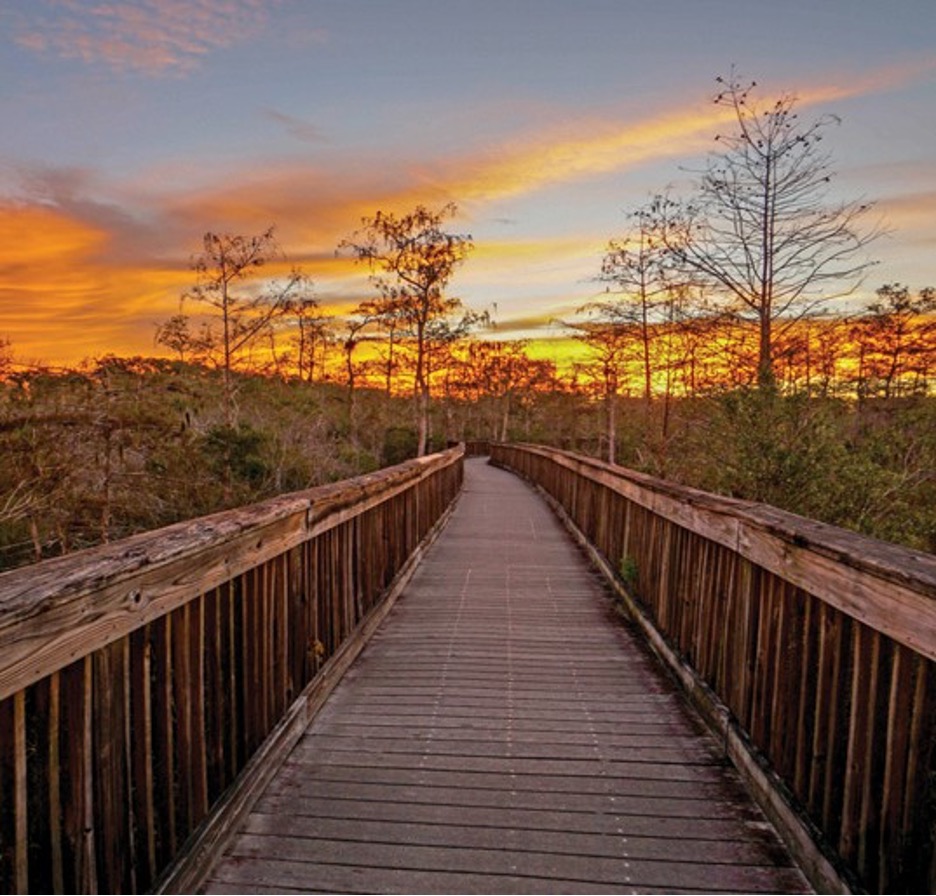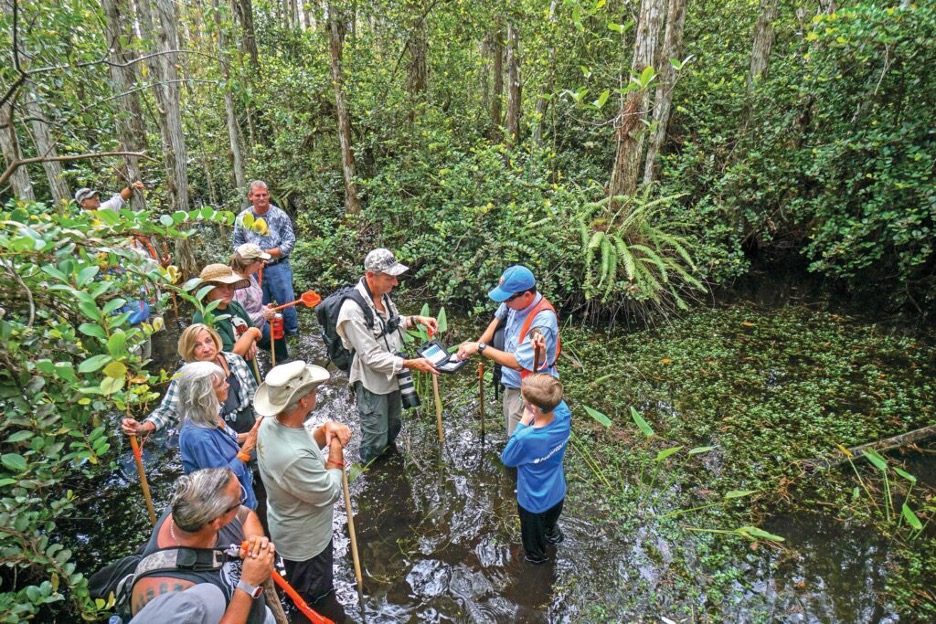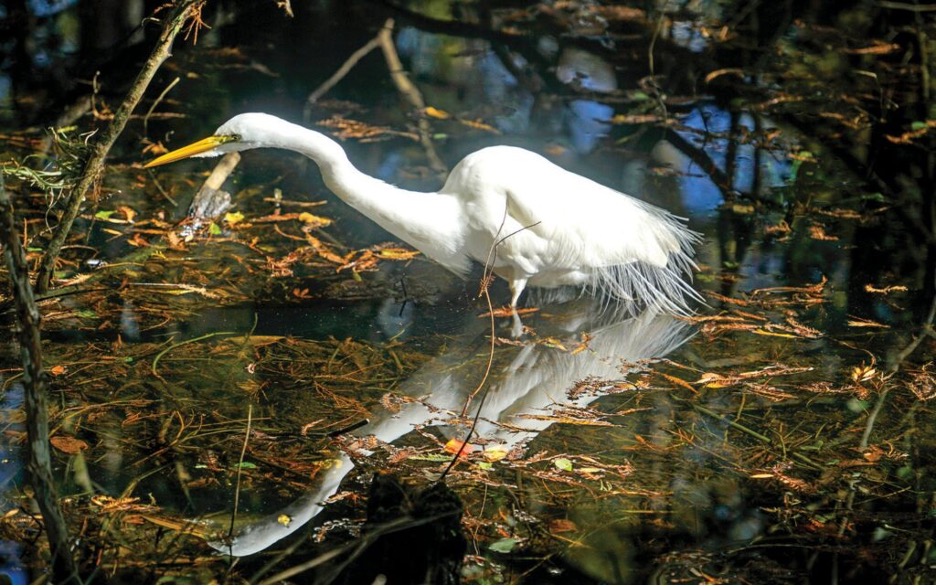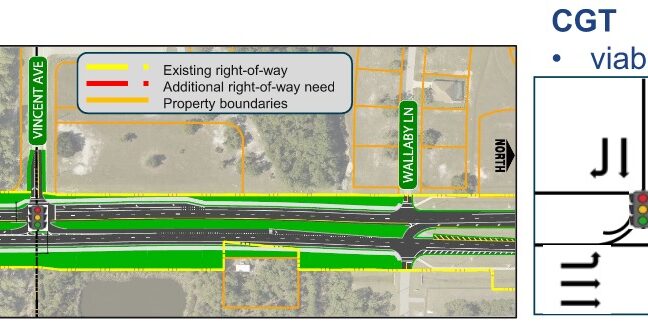
BIG CYPRESS CELEBRATES HALF A CENTURY OF CONSERVATION AND EDUCATION
Encompassing 729,000 acres of swampland that provides a habitat and educational connection to the state’s native wildlife, Big Cypress recently hit its 50-year anniversary of being named as the country’s first national preserve.
In addition to being a neighbor to the more well-known Everglades National Park, the preserve is home to the endangered Florida panther and the extremely rare and elusive ghost orchid.
“Big Cypress is not the Everglades or a park. It is a national preserve that is free to enjoy,” said Lulu Vilas, CEO of The Alliance for Florida’s National Parks. “Big Cypress is such an amazing place and a special reservation. It is right in our backyards, and many people haven’t experienced it since it doesn’t have the big sign and recognition that most national parks have.”
The Alliance for Florida’s National Parks utilizes philanthropic support to promote exploration, advance education, and conservation of national estates, including Big Cypress Preserve. Additionally, through fundraisers held by The Alliance for Florida’s National Parks, Big Cypress hosts educational programs, including walks through the preserve.
“Fifty years is a milestone,” said Scott Pardue, the chief of education and outreach for the preserve. Pardue has been at Big Cypress for three years and has over 30 years of experience with the national parks.
“Many people confuse Big Cypress with the Everglades. Our biggest goal is continuing to get us on the map. We want everyone to know of Big Cypress and to have our local community and visitors come out and explore everything the national preserve has to offer,” said Pardue.
Big Cypress was named to reflect the land’s expansive fresh marshes inhabited by dwarf and bald cypress trees.
Established on Oct. 11, 1974, Big Cypress became the first national preserve in the United States through the controversial efforts of environmentalist Nathaniel P. Reed. The area covers parts of Collier, Dade and Monroe counties and was created to protect its distinctive ecosystem.
“Big Cypress has no coastline and borders the Everglades on the northside. If you are driving on Alligator Alley, you are driving through Big Cypress,” said Vilas.
According to The Collier Resources Company, Barron Collier purchased 1.25 million acres of swamp in Southwest Florida in 1921. In 1974, the Collier family contributed over 76,000 acres to the National Park Service, facilitating the preserve’s establishment while retaining mineral rights for oil extraction primarily located at Bear Island and Raccoon Point. The family also donated another 83,000 acres to expand the preserve in 1996.
Big Cypress is recognized as the “Southernmost Dark Sky Place” in the United States, featuring more than eight campgrounds, including Bear Island, Gator Head, Midway Campground, Mitchell Landing, and Monument Lake.
“Bear Island is a great place to go camping, and you can spot our native black bears there. It is amazing. They tend to be very shy animals,” said Vilas.
Today, Big Cypress has a deep-rooted history in Southwest Florida and remains dedicated to educating residents and visitors about the preserve and wildlife services. According to the National Park Service, Big Cypress draws nearly one million visitors each year and offers outdoor activities that set it apart from neighboring parks.
“Since it is a preserve and not a national park, we have families who live and own land there that has been passed down for generations. There are tent campers, little shacks, and homes. Everyone living on or around Big Cypress wants to be preserved,” said Vilas. “The main difference is the activities permitted, including outdoor sports you couldn’t do at a national park,” said Pardue. “Like the use of off-road automobiles.”
Unlike nationwide parks, Big Cypress authorizes a range of traditional activities, including private property ownership, backcountry cabins, and cultural practices of the Miccosukee and Seminole tribes, as well as hunting, fishing, and the use of swamp buggies or airboats.
Big Cypress has engaged with the public through educational and outreach initiatives, such as swamp walks with local middle schools and guided tours of the renowned Clyde Butcher’s 13- acre property and photo gallery situated within the preserve. “We have a program called ‘SWAMP,’ which stands for ‘Swamp Water and Me Program.’ SWAMP connects our local students to the education of our wildlife through our on-site environmentalists,” said Vilas. The program invites students to become “scientists for a day” by participating in experiments and animal tracking within the preserve. Recently, the Alliance of Florida’s National Parks received a $10,000 grant from Bass Pro Shops, enabling over 75,000 state- based students to continue engaging in the SWAMP program and ranger-led workshops at Big Cypress and nearby parks.
“It has been shown that through hands-on learning, kids connect more to what they learn versus what they are shown in the classroom,” said Vilas. “We have had many of these students return with the interest of working with nature preserves from volunteers and biologists to park rangers.”
“Over 25 years, about 3,000 local kids have come through on this field trip annually. It impacts them and is something we plan on continuing,” added Pardue.
Pardue noted that Big Cypress’s peak season occurs from November to March. While the park receivesfunding from the National Park Service, the events and fundraising organized by The Alliance of National Parks are essential for maintaining the financial gaps of supporting the preserve and providing public and educational seminars, including SWAMP.
“We invite the community to come out and walk one of our four boardwalks or to join our guided bike trails, canoeing trips, and swamp walks. Everything is free, and equipment like bikes and canoes are included. It is a great way to experience Big Cypress,” said Pardue. “It is all about having fun out there.”
“First-timers are always so nervous about getting into the water; they worry about alligators and snakes,” said Vilas. “But as they emerge from the swamp, there is nothing but big smiles on their faces.”


As a preserve, Big Cypress emphasizes conservation tactics, focusing on tracking and studying organisms, restoring forests, and implementing prescribed burns.
“We do specialized burns about every three to five years. The controlled burns are held on only ‘perfect days’ and do the job of clearing dead leaves and debris. Now the local tribes have gotten involved with this, which is important in keeping a healthy wildlife,” said Vilas.
Spanning an area nearly the size of Rhode Island, the land features five distinct habitats: cypress swamps, estuaries, hardwood hammocks, pinelands, and prairies. Each habitat supports a unique mix of flora and fauna, including rare algae species, marsh rabbits, red-cockaded woodpeckers, red groves, manatees, and saw palmettos.
“There is something new to see at every turn,” said Pardue. “Big Cypress Preserve is a spot with the climate to grow and maintain certain wildlife.”
Big Cypress is home to rare species such as the Florida bonneted bat, Big Cypress fox squirrel, and Everglades crabgrass, all of which are not found elsewhere. “The number of alligators and bald eagles has also exploded. The gators are more visible during the dry months and tend to stay together within the water during our rainy season,” said Vilas.
Big Cypress plays a crucial role in preserving the balance of Florida’s natural waterways. Supported by the National Park Service, Big Cypress effectively balances environmental needs with human interests to safeguard the land and its traditional uses for future generations.
“You can be knee-deep in the swamp and still see your feet in our water. It is the cleanest and most filtered water in Southwest Florida and something we work on protecting, especially as the area develops,” said Pardue.
Big Cypress is not the Everglades or a park. It is a national preserve that is free to enjoy.
Vilas explained that the large acreage of land is maintained through a small staff and volunteers. “It is very well attended,” Vilas said. “Our volunteers can grab a new side-by-side and ride the trails. They help with guided tours, talk with campers, and do trail maintenance. Our volunteers go out onto the land and cut back the overgrowth of cocoplum and wax myrtle.”
“We get volunteers from out of state during the season. They bring in their campers and help. It is great for anyone who has retired and wants to enjoy nature. You will want to protect what you know and love,” says Pardue.
Big Cypress was named to reflect the land’s expansive fresh marshes inhabited by dwarf and bald cypress trees. Fifty years after its establishment, the Big Cypress Preserve remains a remarkable destination for experiencing the natural beauty, scenic views, and recreational opportunities of South Florida.
Located at 33100 Tamiami Trail East in Ochopee, Big Cypress welcomes visitors year- round. For inquiries, you can reach them at (239) 695-2000 or nps.gov/bicy/index.htm.
“It is the true wild land,” said Pardue.






